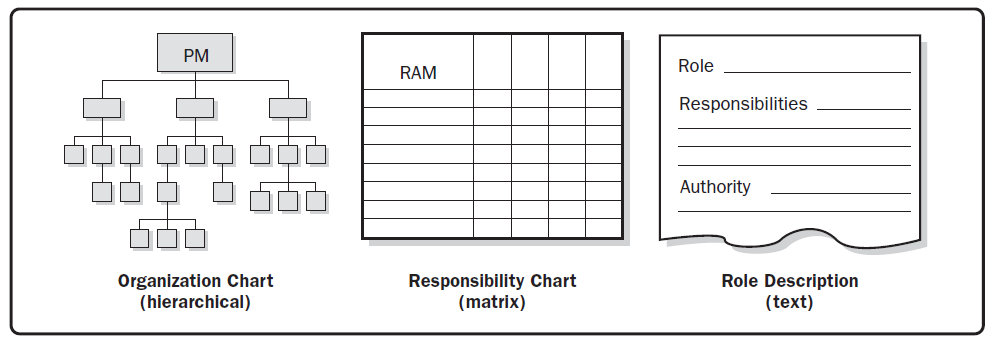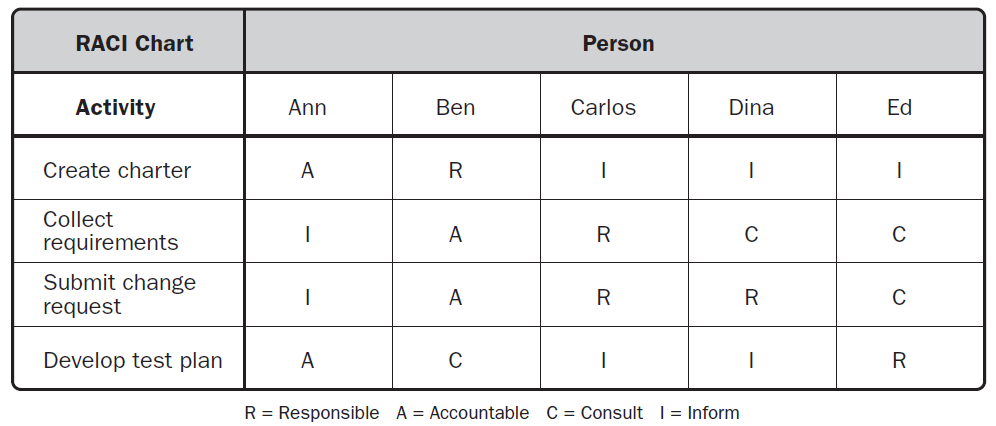RACI (and its variants) is one of the classic tools for business analysts and architects: A Responsibility Assignment Matrix.
Definitions
From: Role & Responsibility Charting (RACI) By Michael L Smith and James Erwin
RESPONSIBLE…..”R”
“The Doer”
The “doer” is the individual(s) who actually complete the task. The “doer” Is responsible for action/implementation. Responsibility can be shared. The degree of responsibility is determined by the individual with the “A”.
ACCOUNTABLE…..”A”
“The Buck Stops Here”
The accountable person is the individual who is ultimately answerable for the activity or decision. This includes “yes” or “no” authority and veto power. Only one “A” can be assigned to an action.
CONSULT……”C”
“In the Loop”
The consult role is individual(s) (typically subject matter experts) to be consulted prior to a final decision or action. This is a predetermined need for two-way communication. Input from the designated position is required.
INFORM…..”I”
“Keep in the Picture”
This is individual (s) who needs to be informed after a decision or action is taken. They may be required to take action as a result of the outcome. It is a one-way communication.
RASCI (also sometimes known as RASIC) is an expanded version of RACI in which the Responsible role from the RACI schema above is broken into two separate roles. Those roles are:
Responsible
Who are responsible for ensuring the task is done as per the Approver’s direction.
Support
Who are assigned to the Responsible role in order to help them complete the task as specified.
Extract from: A Guide to the Project Management Body of Knowledge (PMBOK® Guide) – Fifth Edition. PMI 2013.
9.1.2 Plan Human Resource Management: Tools and Techniques
9.1.2.1 Organization Charts and Position Descriptions
Various formats exist to document team member roles and responsibilities. Most of the formats fall into one of three types (Figure 9-4): hierarchical, matrix, and text-oriented. Additionally, some project assignments are listed in subsidiary plans, such as the risk, quality, or communications management plans. Regardless of the method utilized, the objective is to ensure that each work package has an unambiguous owner and that all team members have a clear understanding of their roles and responsibilities. For example, a hierarchical format may be used to represent high-level roles, while a text-based format may be better suited to document the detailed responsibilities.

- Hierarchical-type charts.
The traditional organization chart structure can be used to show positions and relationships in a graphical, top-down format. Work breakdown structures (WBS) designed to show how project deliverables are broken down into work packages provide a way of showing high-level areas of responsibility. While the WBS shows a breakdown of project deliverables, the organizational breakdown structure (OBS) is arranged according to an organization’s existing departments, units, or teams with the project activities or work packages listed under each department. An operational department such as information technology or purchasing can see all of its project responsibilities by looking at its portion of the OBS. The resource breakdown structure (RBS) is a hierarchical list of resources related by category and resource type that is used to facilitate planning and controlling of project work. Each descending (lower) level represents an increasingly detailed description of the resource until small enough to be used in conjunction with the work breakdown structure (WBS) to allow the work to be planned, monitored and controlled. The resource breakdown structure is helpful in tracking project costs and can be aligned with the organization’s accounting system. It can contain resource categories other than human resources. - Matrix-based charts.
A responsibility assignment matrix (RAM) is a grid that shows the project resources assigned to each work package. It is used to illustrate the connections between work packages or activities and project team members. On larger projects, RAMs can be developed at various levels. For example, a high-level RAM can define what a project team group or unit is responsible for within each component of the WBS, while lower-level RAMs are used within the group to designate roles, responsibilities, and levels of authority for specific activities. The matrix format shows all activities associated with one person and all people associated with one activity. This also ensures that there is only one person accountable for any one task to avoid confusion of responsibility. One example of a RAM is a RACI (responsible, accountable, consult, and inform) chart, shown in Figure 9-5. The sample chart shows the work to be done in the left column as activities. The assigned resources can be shown as individuals or groups. The project manager can select other options such as “lead” and “resource” designations or others, as appropriate for the project. A RACI chart is a useful tool to use when the team consists of internal and external resources in order to ensure clear divisions of roles and expectations.

- Text-oriented formats.
Team member responsibilities that require detailed descriptions can be specified in text-oriented formats. Usually in outline form, the documents provide information such as responsibilities, authority, competencies, and qualifications. The documents are known by various names including position descriptions and role-responsibility-authority forms. These documents can be used as templates for future projects, especially when the information is updated throughout the current project by applying lessons learned.